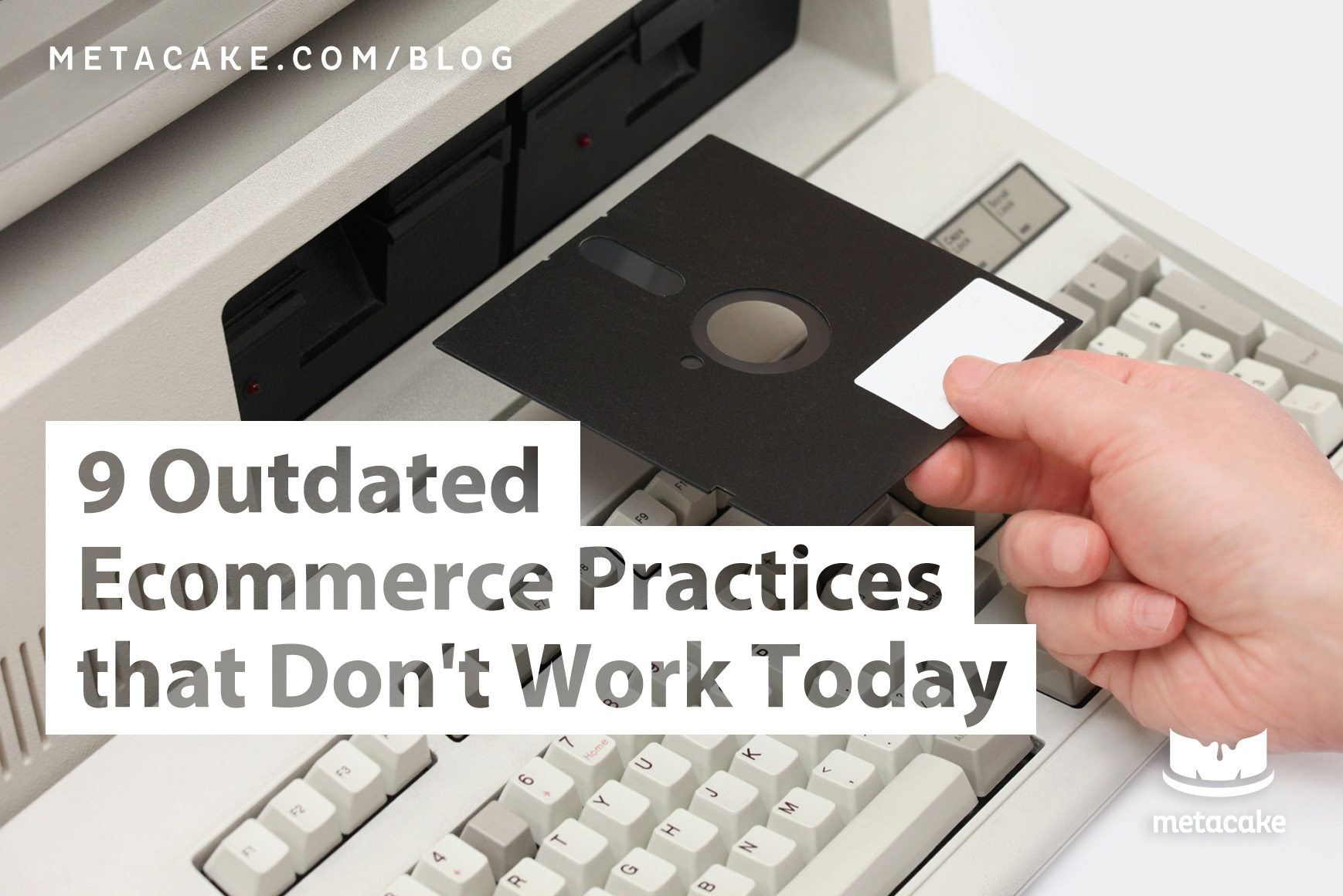
9 Outdated Ecommerce Practices That Don’t Work Today
Updated: April 21, 2023
It’s no secret that the ecommerce world has grown rapidly over the last decade. And in the last few years, we’ve seen things change at an precedented rate.
We’ve heard stories of brand after brand that boomed in 2019 or 2020, but have not been able to keep the momentum and ended up falling by 2022 or are currently struggling in 2023. It’s sad to hear, but it reminds us of an important truth. The world of ecommerce tends to have a lot of fads that come and go. If you rely on those trends for revenue, you will not win in the long run.
At Metacake, our mission is to be a resource for healthy ecommerce growth strategies. These strategies are rooted in over a decade of experience and timeless truths that promote steady business growth for brands of all sizes.
In this post, we’re going to share nine practices that may have worked for ecommerce businesses in the past but no longer do. We’ll also provide tips for what you should implement instead so you can get off the rollercoaster that comes with following the trends!
9 Ecommerce Techniques That No Longer Work Today
1. Relying on a single marketing channel for the majority of your revenue
Are you relying on Facebook and Instagram ads for the majority of your traffic and sales? If so, you’re probably already in trouble.
Not too long ago, ecommerce brands could launch Facebook ads, see ROAS shoot through the roof, and rely on that traffic to fuel their sales. With data privacy changes and increased competition, those days are no more.
Here’s the good news: Living off of one advertising channel is quite risky, so diversifying your marketing channels is a good move anyway. Now is more important than ever to use a multi-step funnel approach for your marketing:
- Add additional advertising channels like Google Search, Google Shopping, YouTube, or TikTok.
- Invest in your email marketing program. This is an “owned” channel and can contribute up to 20-30% of revenue for brands who prioritize it.
- Use organic marketing methods such as social media and SEO.
- Use conversion rate optimization (CRO) on your website to ensure there are no holes in the website funnel and you are converting as much of your traffic as possible.
2. Dropshipping cheap products instead of building a real brand
Are you dropshipping your products, hoping to make quick profits off a cheap product with minimal effort? Or maybe you have your own ecommerce store, your own products, and handle your own fulfillment, but you’re having trouble getting repeat purchases.
Either way, if you want to be in business for the long haul, it’s time to get serious about creating a real brand. Develop a product line strategy that encourages customers to come back and buy from you again. Dial in your brand’s look, feel, messaging, and purpose so you can connect with customers and build loyalty. These are the investments that differentiate a fad from a brand that lasts.
3. Not being intentional about your customer journey
Is your website’s conversion rate decreasing, or just lower than it should be? Is your customer lifetime value (or average order value) lower than 3x your average product price? Are your paid ads not performing well?
All of these could be signs that your customer journey needs work. Instead of thinking about your marketing channels and sales channels in isolation, they should all work together as a cohesive experience for the customer. Every ad, landing page, email, product detail page, and more should tell your brand’s story, connect with the customer, build trust, and build excitement for the product. The customer journey should also be easy to follow with minimal distractions in order to convert the most visitors possible.
A majority of your customer’s journey takes place on your website, so getting every page right is a must. If you need a step-by-step blueprint outlining the ideal structure and content for every page on your ecommerce store, be sure to check out our guide The Perfect Ecommerce Website.
4. Only selling on Amazon (or relying heavily on Amazon for sales)
Is the majority of your revenue (50% or more) coming from Amazon or another marketplace? Even if it seems to be going well now, this is a risky place to be. What if they decide to de-list your products or your account gets shut down? What if there is a change to the marketplace algorithm and you don’t get as much visibility? What if competitors copy your product and sell it for less?
If you want to be a stable, healthy, successful business, diversifying your sales channels is a must. Being present on Amazon can be a part of a healthy ecommerce strategy, but it can’t be your whole strategy. While Amazon can be a great resource for you, your own DTC store should lead your business. You don’t own any customer information for the sales you make on Amazon. You can’t follow up with customers to cross-sell, remind them to purchase again, add value, or get their feedback. If the majority of your customers come from your own ecommerce store, you own that customer database and can use it to build a business.
Typically we recommend the following channel mix:
- Ecommerce: 40% (or more)
- Marketplace: 20%
- Wholesale: 20%
- Affiliates: 10%
- Offline: 10%
5. Getting by with low margins
Are you seeing revenue but having trouble making actual profit? Do you spend most of your revenue on advertising? Is your budget too small to afford an amazing return policy and awesome customer service?
All of the elements that make up a great business — brand storytelling, effective advertising, thoughtful email strategy, a risk-eliminating warranty or return policy, great customer service, a strategic website, research and development, and more— are only possible when you have optimal product margins.
Product margins are one of five golden multipliers needed for a booming ecommerce business. The other four include:
- Average order value (AOV)
- Average customer lifetime value (LTV)
- New customers
- Conversion rate
If you’re answered yes to the questions above, it’s time to invest in your brand, as well as in research and development, to develop a product line that has healthy margins and keeps customers coming back to purchase again and again.
6. Thinking slow, expensive shipping is acceptable
Does your product take awhile to ship? Do your customers hate having to pay for shipping? Or worse, are you losing potential customers to Amazon because of your shipping fees?
Amazon Prime has definitely changed the way consumers look at shipping. People have come to expect orders to come quickly and not have to pay very much for them to appear on their doorstep. As an ecommerce business, you likely can’t compete with Prime in terms of shipping, but there are a couple of things you can do to help.
First, if possible, try to build the cost of shipping into your products’ price. This is similar to having good margins. This way, you can charge your customers less for shipping and there is less “unexpected” sticker shock at checkout.
Next, test free shipping tiers or expedited shipping tiers. Offering free shipping for orders over $X can help increase your average order value while also making customers happy.
7. Running unorganized (or spontaneous) marketing, launches, and promotions
Are the promotions that you’re running falling flat? Are Black Friday and Cyber Monday insanely stressful? Do you go into promos or product launches having no concept of how much revenue you will bring in?
In order to succeed and create predictable revenue, you need a scalable system.
Promotions and product launches are the lifeblood of an ecommerce brand’s marketing calendar. We recommend running events like this every 6-8 weeks and having an organized system for creating, launching, and running the campaigns for maximum return.
Here at Metacake, we offer a course called the Ecommerce Promotions Bootcamp that teaches our system for getting the most out of your promotions while also being as efficient and stress-free as possible. Contact us here and mention Bootcamp for more information!
Additionally, don’t forget to also develop a content strategy that will keep customers engaged in the down time between promotions and launches. Use email marketing and your store’s blog to create helpful or interesting content that your customers will find valuable. This will help build trust and relationships with your customers and differentiate your brand from your competition.
8. Relying on one product (or just a few)
Are you hitting a ceiling with your revenue? Do you have very few repeat customers and low lifetime value? Was your product a trend at one time and is now on its way out?
The only solution for this — and for any ecommerce business that wants to last— is research and development (R&D). Many brands put off investing in R&D because it doesn’t feel like an immediate need. But if you wait until you “need” R&D, it’ll be too late. Whether you’re just getting started or have been in business a long time, consistent innovation is a necessity.
The main purpose of R&D is to develop a product line that is timeless, or at least prepared to replace fad-based products with new ones. Your product line should also create opportunities for customers to buy again. If your product is not consumable or something that needs to be replaced regularly, be sure to develop complementary products so customers have reason to purchase over and over again.
9. Blindly trusting tacticians and gurus for marketing success
We see this a lot. Oftentimes, leaders of businesses are not marketing experts, nor do they have the time to learn the skill, let alone the complicated advertising platforms. So, they put their trust in tacticians and advertising gurus to set their strategy and execute it. And when they don’t see results, they have no idea where they went wrong.
It’s time to change that. Because there is nothing worse than hitting a problem and not knowing how to solve it. Or, spending money on advertising that isn’t working anymore and you’re not sure why.
If you want to successfully run an ecommerce brand, you’ll need to understand all elements of ecommerce marketing at a high level. You don’t need to know how to run the ads themselves. But you do need to understand how different marketing channels work together so you can lead a sound strategy. Our series of articles called “The Executive’s Guides” can help give you a helpful overview for many of topics related to this!
Next, you’ll need to bring on trusted advisors to guide decision making as well as implement campaigns. Whether you’re looking for ecommerce coaching and consulting, or for tacticians to run your marketing, our team of experts can help.
Timeless Strategies for More Effective Business Growth
Ecommerce trends come and go, but the strategies we’ve discussed here are basic principles that lay the groundwork for a business that lasts.
We’ve helped hundreds of ecommerce brands of all sizes find healthy growth using these methods for over a decade. If you’re in need of a team of experts who can…
- Help dial in your brand
- Improve your customer journey
- Increase conversions on your website
- Build a revenue-driving email marketing program,
- Develop paid marketing strategies that work
- And more…
Contact us today. We’d love to talk about how we can help unlock your brand’s next level of growth!



